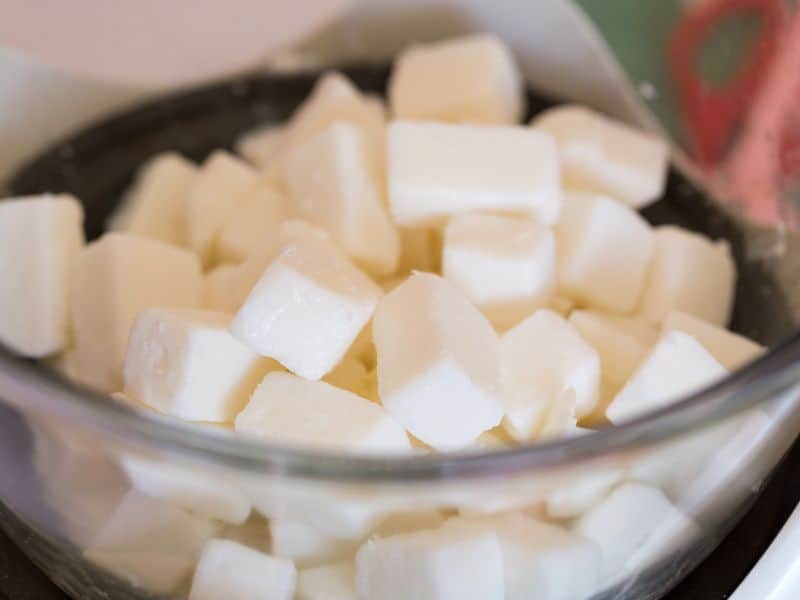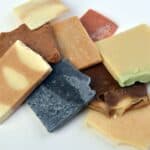Cold process soap making is a fun and rewarding hobby, but sometimes challenges can make you want to redo your soap. In this article, we’ll look at cold process soap and whether cold process soap can be remelted, as well as discuss other alternatives.
Remelting cold process soap is possible, but has inconsistent results. Instead, try rebatching it by combining it with a new cold process batch, gently heating it, and reshaping it for a more reliable and controlled outcome. Rebatching allows adding extra colors, fragrances, or additives to the soap.
Rebatching is a practical solution when you have soap scraps or a batch that didn’t turn out as expected. By combining your existing cold process soap with a new batch, you can enhance its appearance and properties.
This technique gives you the chance to experiment with various ingredients, while saving time and resources compared to starting from scratch. Plus, it’s an eco-friendly approach to reusing materials and minimizing waste in your soap-making endeavors.
Let’s take a closer look at what all you can do to salvage your cold process soap below.
Understanding Cold Process Soap
Cold process soap making is a popular method that involves mixing oils and lye to create a chemical reaction called saponification. This process turns oils into soap without the need for external heat, allowing the mixture to naturally heat up and then cool down as it hardens.
Saponification is the heart of soap making. When oils and lye mix, they transform into soap and glycerin. This reaction takes time, usually 24 to 48 hours, before the soap is safe to touch. After that, it needs to cure for 4 to 6 weeks, allowing excess water to evaporate, resulting in a harder and milder bar of soap.
Key ingredients in cold process soap are oils, lye, and water. Oils can include olive, coconut, and palm, while lye is a caustic solution made from sodium hydroxide or potassium hydroxide. These ingredients, combined with water, create the foundation of cold process soap.
Remelting Cold Process Soap: Is It Possible?
Remelting cold process soap can be tricky, as factors like the soap’s age, composition, and technique used play a role. Success depends on the oils, lye concentration, and curing time.
Fully cured and well-saponified soap may be difficult to remelt due to its hardened texture.
High heat might negatively affect the soap’s structure, texture, and ingredient balance.
Some fragrances or additives might not survive the process, and their distribution in the soap may be uneven.
Remelting may not correct initial soap making mistakes, like incorrect lye measurements. It often works better to combine the soap you want to remelt with a new batch of cold process soap, as it provides better control and consistency.
Although remelting cold process soap is possible, it can be challenging and might lead to inconsistent results.
Rebatching Cold Process Soap
To rebatch cold process soap successfully, follow these detailed, step-by-step instructions:
- Prepare the soap: Grate the soap into fine particles using a cheese grater, or chop it into tiny, pea-sized pieces with a knife. Smaller pieces will ensure even melting and a smoother final texture. Add it to a new batch of cold process or rebatch it by itself.
- Add liquid: Measure out just enough liquid (distilled water, goat milk, or herbal tea) to moisten the soap shreds without making them soggy. Excess liquid will prolong the curing time, so use caution when adding the liquid.
- Set up a double boiler or slow cooker: To gently warm the mixture and prevent scorching or overheating, use a double boiler or a slow cooker set on low heat. Place the soap and liquid mixture in the top pan of the double boiler or directly in the slow cooker.
- Heat and stir: As the soap mixture heats, stir it occasionally to ensure even melting and minimize the formation of lumps. This will also help to incorporate the added liquid evenly throughout the soap.
- Monitor consistency: Keep an eye on the soap as it heats, aiming for a thick, mashed potato-like consistency. It may take some time to achieve this, so be patient and continue stirring occasionally.
- Add fragrances, colorants, or other additives: Once the soap has reached the desired consistency, mix in any desired fragrances, colorants, or additional additives. Be sure to blend them well for an even distribution throughout the soap.
- Mold the soap: Carefully pour or spoon the soap mixture into your preferred soap molds, smoothing the surface with a spatula or the back of a spoon. If using individual cavity molds, be sure to tap the molds on the counter to release any trapped air bubbles.
- Allow the soap to cool: Let the soap cool and harden in the molds for at least 24 hours, or until it’s firm enough to remove.
- Unmold and cure: Gently remove the soap from the mold and cut it if necessary, place it on a curing rack or a sheet of wax paper in a cool, dry, and well-ventilated area. Allow the soap to cure for 4-6 weeks, or until it’s completely hardened.
By following these steps, you can successfully rebatch your cold process soap and create new bars with added colors, fragrances, or other unique features.
Tips for Better Cold Process Soap Making
To enhance your cold process soap making skills, follow these tips:
- Precise measurements are crucial for consistent results. Use a digital scale to accurately weigh oils, lye, and water, ensuring the right balance of ingredients.
- Practice patience during the curing process. Allow the soap to cure for 4 to 6 weeks to achieve a milder, longer-lasting bar. Resist the temptation to use the soap prematurely, as it may be harsh or crumbly.
- Experience is the best teacher. Don’t be disheartened by initial setbacks; continue experimenting with different oil combinations, fragrances, and colorants to develop your unique style. Learn from your mistakes, and remember that practice makes perfect.
Creative Alternatives to Remelting
Rather than attempting to remelt cold process soap, consider some of these creative techniques.
- Creative ways to repurpose soap scraps
- Make soap balls by rolling soap scraps between your hands, compressing them tightly, and then allowing them to cure.
- Put small soap pieces in a mesh or organza bag for a convenient, exfoliating shower scrub that uses every last bit.
- Combine soap scraps with distilled water and glycerin in a blender to create a smooth liquid hand soap or body wash.
Frequently Asked Questions
Rebatching is a process that involves grating existing soap, gently heating it, and adding additional ingredients, such as colors, fragrances, or additives, before reshaping it into a new bar.
Factors include the type and amount of oils, lye concentration, curing time, and the specific technique used in the initial soap making process.
Rebatching allows for the addition of delicate ingredients, fixing minor errors in the original soap batch, and creating a more controlled outcome.
Rebatching involves grating the soap, adding a small amount of liquid, and gently heating it until it softens. Additives can then be mixed in before reshaping the soap.
Water, milk, or other liquids can be used. Milk, such as cow’s, goat’s, or coconut milk, can help achieve a smoother consistency.
Yes, rebatching can help fix minor mistakes made during the original soap making process, such as missing ingredients or incorrect proportions.
The rebatching process can take several hours, depending on the method used and the desired consistency.
Conclusion
In conclusion, while remelting cold process soap is feasible, it can be challenging and yield inconsistent results. Rebatching, on the other hand, offers a more reliable and controlled method for repurposing soap, allowing you to add extra colors, fragrances, or additives.
By understanding the factors that affect remelting and exploring alternative techniques like rebatching, you can make the most out of your soap-making experience, minimize waste, and create high-quality, personalized products.
Always remember to practice proper measurements, be patient during the curing process, and continually hone your skills to achieve the best results in your soap-making journey.






